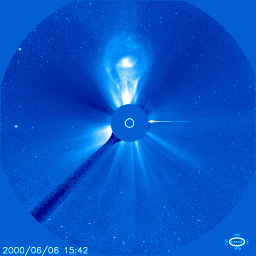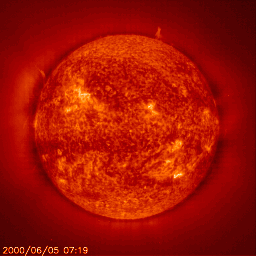Science Fiction
Dictionary
A B C D E F G H I J K L M N O P Q R S T U V W X Y Z
Solar-Powered Interplanetary Shock Tracked To Saturn

In a dramatic proof that solar coronal mass ejection (CME) events affect even the outermost portions of the Solar System, scientists have traced an interplanetary shock from the Sun to Earth to Jupiter to Saturn.

(coronal mass ejection)
They report the discovery of a strong transient polar emission on Saturn, tentatively attributed to the passage of an interplanetary shock. The shock-triggered events were first seen here on Earth, where auroral storms were recorded. Next, auroral activity on Jupiter was seen to be strongly enhanced. Finally, the unusual polar emission on Saturn was noted. This sequence of events establishes that shocks retain their ability to trigger planetary auroral activity throughout the Solar System.
In their 1992 science fiction book Flare, Roger Zelazny and Thomas T. Thomas chronicle the effects of a huge solar flare as it wreaks havoc across the inhabited worlds and space stations of the solar system. The effects of this event on the orbiting EverRest Cryotorium were described as follows:
The EverRest Cryotorium orbited low over the Earth ... forgotten by a handful of individuals ... some who worked daily in the NASA Department of Decaying Orbital Artifacts - the "Trash Squad."However, with the unaccustomed surge of electromagnetic noise that was echoing throughout the inner solar system, and with the ensuing panic as normmaly talkative human beings discovered that their multiplex communications system was effectively blanked out, no one happened to be looking at the sky.
Unappreciated by these people, for the past twenty minutes the ionosphere 500 kilometers uner the EverRest's keel had been absorbing huge blasts of intense radiation from the solar flare.
The air density at such a height above the Earth's surface is quite thin: ranging from two millionths down to five billionths of a gram per cubic meter... the molecular fragments remain at their current altitude because the collective collisions of their gas pressure, energized by the sun's radiation, propel them upwards against the pull of gravity... heat the gas and you increase its pressure. Without confining walls or a steel tank to contain it, the volume of gas expands.
...the continuous influx of high-energy radiation had trippled the ambient temperature of the lower ionosphere. The resulting swell in the volume of gas pushed upward, increasing the density of material in EverRest's immediate vicinity by about fifty times.
The effect was immediate.
The orbiting hull reacted as if it had hit a wall.
(Read more from Flare)
Solar flares occur when magnetic energy built up in the solar photosphere is suddenly released. Radiation across the entire electromagnetic spectrum is released; the energy released can equal that of a million 100 megaton hydrogen bombs exploding at the same time. The first flare recorded occurred in 1859. A solar flare in 1989 blacked out all of Quebec, Canada. Solar flares in 1998 knocked out the Galaxy 4 satellite, causing eighty percent of the pagers in North America to fall silent.

(From Solar Flare)
The sun's corona is highest region of the solar atmosphere; it can be seen during a total eclipse as a large halo of white, glowing gas extending several solar radii from the solar disk. A special telescope called a coronagraph that artificially eclipses the sun's disk is used to study the solar corona on a regular basis. A coronal mass ejection (CME) can occur without a flare, although they are often associated. A CME can carry up to 10 billion tons of electrified gas traveling at speeds of up to 2,000 kilometers per second. Fortunately, our planet's magnetic field serves as shield against these storms.
The results were published in a letter to the journal nature by Renee Prange, Laurent Pallier and Regis Courtin (LESIA, Observatoire de Paris); Kenneth C. Hansen (Department of Atmospheric, Oceanic and Space Sciences, University of Michigan); Russ Howard and Angelos Vourlidas (Naval Research Laboratory); and Chris Parkinson (California Institute of Technology, JPL and the NASA Astrobiology Institute). Read An interplanetary shock traced by planetary auroral storms from the Sun to Saturn.
Scroll down for more stories in the same category. (Story submitted 11/3/2004)
Follow this kind of news @Technovelgy.| Email | RSS | Blog It | Stumble | del.icio.us | Digg | Reddit |
Would
you like to contribute a story tip?
It's easy:
Get the URL of the story, and the related sf author, and add
it here.
Comment/Join discussion ( 0 )
Related News Stories - (" Space Tech ")
Will Space Stations Have Large Interior Spaces Again?
'They filed clumsily into the battleroom, like children in a swimming pool for the first time, clinging to the handholds along the side.' - Orson Scott Card, 1985.
Reflect Orbital Offers 'Sunlight on Demand' And Light Pollution
'I don't have to tell you about the seven two-mile-diameter orbital mirrors...'
Chrysalis Generation Ship to Alpha Centauri
'This was their world, their planet —
this swift-traveling, yet seemingly moveless vessel.' - Nat Schachner, 1934
The First Space Warship For Space Force
'Each of the electrical ships carried about twenty men...' - Garrett P. Serviss, 1898.
Technovelgy (that's tech-novel-gee!) is devoted to the creative science inventions and ideas of sf authors. Look for the Invention Category that interests you, the Glossary, the Invention Timeline, or see what's New.
Science Fiction
Timeline
1600-1899
1900-1939
1940's 1950's
1960's 1970's
1980's 1990's
2000's 2010's
Current News
Jetson ONE Air Races Begin, Can Air Polo Be Far Behind?
'If you're one of those rarities who haven't attended a rocket-polo "carnage", let me tell you it's a colorful affair.'
Will Space Stations Have Large Interior Spaces Again?
'They filed clumsily into the battleroom, like children in a swimming pool for the first time, clinging to the handholds along the side.'
Mornine Sales Robot
'Robot-salesmen were everywhere, gesturing...'
Bipedal Robot Floats Gently While Walking
'a walking balloon proceeded with long strides of its aluminum legs...'
Musk Idea Of Cars Talking To Each Other Predicted 70 Years Ago
'My cars talk to one another.'
Elegant Bivouac Shelter Produces Water And Electricity
'There was nowhere on the planet where science and technology could not provide one with a comfortable home...'
X-Control Janus-1 A Suitcase Aircraft
'You will notice that it... fits the suitcase nicely.'
'AI Assistants' Are Actually Less Reliable For News
'Most men updated their PIP on New Year's Day...'
YES!! Remote Teleoperated Robots predicted by Technovelgy!
'...a misshapen, many-tentacled thing about twice the size of a man.'
Will Robots Ever Fold Landry?
Where have you gone, Mrs. Robinson?
Will AIs Give Better Results If You're Rude To Them?
'I said, "Listen up, motherf*cker.'
Cybertruck Robotic Arm F10 Drone Launch!
Drone away!
Black Fungus Blocks Radiation
'You were surrounded by Astrophage most of the time'
Liuzhi Process Now In Use In China
'He was in a high-ceilinged windowless cell with walls of glittering white porcelain.'
Reflect Orbital Offers 'Sunlight on Demand' And Light Pollution
'I don't have to tell you about the seven two-mile-diameter orbital mirrors...'
Will Robots Become Family Caregivers?
'The robant and the tiny old woman entered the control room slowly...'
